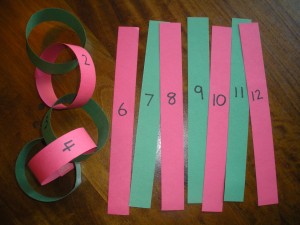Paper Chain Math
Not only are paper chains fun to make but there’s a lot of great math in them, too! And the best part is, making them is super easy. All you need is colored construction paper cut into one inch strips, clear tape, and a pen.
PreK-K Activities
Patterning: Math is made up of patterns which are often introduced in the early years through repeating patterns activities. To create a simple repeating pattern in your paper chain, choose two colors to work with and alternate the colors as you string the loops together. Have your child lay out the strips in the pattern before adding them to the chain. Ask her to predict which color to lay down next and tell you why she chose that color.
Time concepts: Young children have a hard time waiting for special events like their birthday or an upcoming holiday. And that makes sense because time is a very abstract concept. Paper chains are a great way to give them some concrete experiences with the passage of time.
Have your child create a paper chain made up of the same number of loops as days to the special event. Hang it someplace where he can easily see and touch it. Each morning, have him remove one loop until, finally, he gets to remove the last loop on the special day.
Tying in numbers: An easy way to expose young children to numbers is to label each one of the loops starting with the number ‘1’ at the top of the loop. Each day, count the loops with your child before having her remove that day’s loop. This will help her learn the number sequence…and get some beginning subtraction practice!
K-1 Activities
Skip counting: For kindergartners, consider making the paper chain in multiples of 10. This will help them learn the decade names and reinforces the single-digit sequence through counting on. For example, make the numbers 1-10 one color, 11-20 a second color, etc. As you count the number of days left, they will learn that the numbers 1, 2, 3, 4, 5, 6, 7, 8, and 9 repeat after each decade. If counting to 34 it would sound like: 10, 20, 30, 31, 32, 33, 34. (The teen numbers do not follow this pattern and are often confusing to young children. Plenty of counting opportunities will help them solidify the “teens”.)
First graders can alternate colors in groups of five. Then they can skip count by fives when figuring out how many days remain before the big event. It, too, provides kids with opportunities to count on. For example, if there are 17 days left, point to the numbers on the chain as you count: five, ten, fifteen then count on by ones…sixteen, seventeen.
Even and Odd Numbers: Write numbers on a two-color repeating pattern paper chain. All the even numbers will be one color and the odd numbers the other color. Help your child skip count by evens then odds.


One thought on “Paper Chain Math”
Great way to learn math. Good math article.